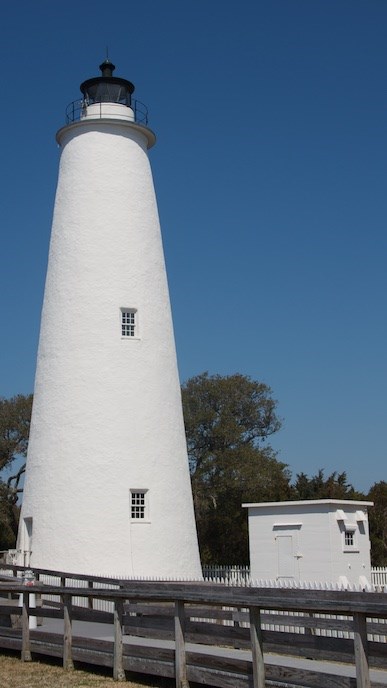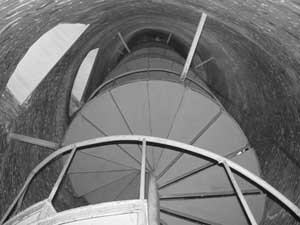
National Park Service Visiting the LighthouseThe Ocracoke Lighthouse is located in Ocracoke Village at the southern end of Cape Hatteras National Seashore. The lighthouse is not open for climbing, but the base of the lighthouse is open with limited hours during the summer months. Check at the Ocracoke Discovery Center for hours. The street address is
Lighthouse HistoryOcracoke Inlet was first placed on the map when the flagship Tyger of Sir Walter Raleigh's 1585 expedition to Roanoke Island ran aground there in 1585. Although the Tyger was re-floated it was carrying the bulk of food supplies for the expedition which were spoiled by salt water. This incident at "Wococon" inlet would have dire consequences for the success of the expedition and resulted in a chain of events that would ultimately shape the history of the Outer Banks. Two centuries later, this was one of the busiest inlets on the East Coast. During the Revolutionary War, supplies for General Washington's Continental army were guided through Ocracoke Inlet. Ocracoke Inlet was the only reasonably navigable waterway for ships accessing inland ports such as Elizabeth City, New Bern, and Edenton. Ocracoke Village, then known as Pilot Town, developed as a result of the inlet's use. Pilots, hired to steer ships safely through the shifting channels to mainland ports, settled the village in the 1730s. The US Lighthouse Service recognized that a lighthouse was needed to assist mariners through Ocracoke Inlet. In 1794, construction began on Shell Castle Island, a 25 acre, shell-covered island located between Ocracoke and Portsmouth Island to the south. This site was adjacent to the deepest inlet channel between shallow Pamlico Sound and the ocean. A wooden, pyramid-shaped tower was completed four years later. In addition to the light, a small lightkeeper’s house was built along with several cargo wharves, gristmills, houses, and other facilities. 
National Park Service Unfortunately, the lighthouse, a great blessing to mariners, was obsolete in less than 20 years due to the migration of the main channel. By 1818, the channel had shifted nearly a mile away. That same year, both the lighthouse and keeper’s house were destroyed by lightning. On May 7, 1822, Congress authorized $20,000 for the construction of a lighthouse at the south end of Ocracoke Island and a two-acre plot of land was purchased for $50 from Jacob Gaskill. The contract for construction of the lighthouse was signed on June 20, 1823 and awarded to builder Noah Porter. The lighthouse, along with a keeper's quarters, was completed by December of that year for a total of $11,359, far below the $20,000 budgeted. By the summer of 1824 the first lighthouse keeper, Anson Harker, arrived at Ocracoke Light Station to tend the light and maintain the station. Correspondence records indicate that the Ocracoke Lighthouse was first lit on August 15, 1824. Delays between the completion of lighthouse construction and the actual lighting of a lighthouse were not uncommon. This was usually because a Keeper had not been found to man the lighthouse and sometimes fuel could not be supplied for several months. In the case of Ocracoke Lighthouse, disputes between the government and the contractor over construction methods and final payment in the winter of 1824 delayed the appointment of the first keeper until six months after construction ended, which ultimately delayed the lighting of the lighthouse. A fourth-order Fresnel lens was installed in 1854, replacing the old reflector system. Its hand-cut prisms and magnifying glass greatly intensified the light. Early in the Civil War, the lens was dismantled by Confederate troops but was re-installed in 1864 by Union forces. Originally an oil-burning light, the Ocracoke Light was electrified by a generator in 1929. The present light is equal to 8,000 candlepower and casts a stationary beam that can be seen 14 miles at sea. A battery powered back-up light operates during power failures. 
National Park Service As duties at the lighthouse increased, an assistant keeper position was established. To house the additional keeper and his family, a second story was built onto the original quarters in 1897 and another section was added in 1929. The double keepers' quarters still stands on the site today, along with other station buildings including the oil house, generator house, privy, storehouse, and carpenter's shop. Keepers performed a wide range of duties. Maintaining the buildings and grounds, hauling oil, trimming wicks, and polishing the lens were part of a well-trained lightkeeper's regulated life. Ocracoke lighthouse keepers fished, hunted waterfowl, raised livestock, and planted gardens. Due to the proximity of the village, the keepers and their families enjoyed a social life on Ocracoke and their children were schooled in the village. The US Lighthouse Service provided a traveling library to their isolated employees. Cases of library books were circulated every six months to light stations along the coasts. 
National Park Service During hurricanes, the light station served as a place of refuge for some local residents. Situated on higher ground, the complex often remained above flood waters. Villagers, sometimes arriving by boats which navigated inundated roadways, waited out the storm in the keepers’ home. In 1939, the United States Coast Guard took over management of our nation's lighthouses. The Coast Guard oversaw the transition of lighthouses from manned to unmanned stations. 1954 was a pivotal year at Ocracoke Light Station because the Lighthouse became fully automated and no longer needed a resident keeper to tend to daily needs. Through federal grants, the National Park Service conducted a structural analysis of the lighthouse. Preservation work was then performed on the tower’s windows, door, and brick walls. In 2019, Hurricane Dorian greatly impacted the light station and flooded the Keepers' Quarters with 18 inches of water. To increase storm resiliency, the National Park Service began a project to raise the Keepers' Quarters 4 feet. Work is expected to begin in 2023 and be complete in 2025. Due to the narrow nature, small doors, and ladders needed to access the top of the Lighthouse, it is not open for climbing. During the summer months, the base of the lighthouse is open during limited hours. Check at the Ocracoke Discovery Center for more information. Virtual Tour of Ocracoke Light Station and Lighthouse Climb
Visit our keyboard shortcuts docs for details
Join Ranger Alisa as she takes us on a tour of the Ocracoke Light Station and a climb of the 200 year old Ocracoke Lighthouse. |
Last updated: October 12, 2023
